Dias Maritime Museum

Beez Neez now Chy Whella
Big Bear and Pepe Millard
Fri 10 Jan 2020 23:47
|
Dias Maritime
Museum
 On entering the Maritime Museum, we were met by Bartholomew Dias.
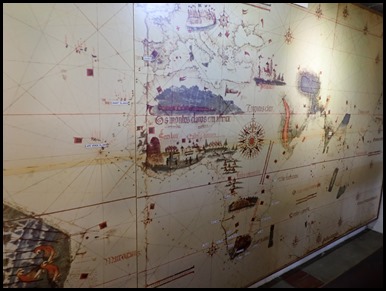 We bimbled down some steps and ahead of us was an impressive wall
map. The Cantino Planisphere, 1502. “The Precious Jewel of Portuguese Cartography” made by an
unknown Portuguese cartographer in 1502, after Vasco Da Gama’s voyage to India,
was acquired clandestinely in Lisbon by the Italian, Alberto Cantino.
Possible the Padrao or standard map of the world, on which new discoveries
was recorded.
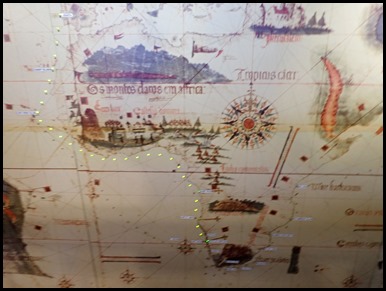 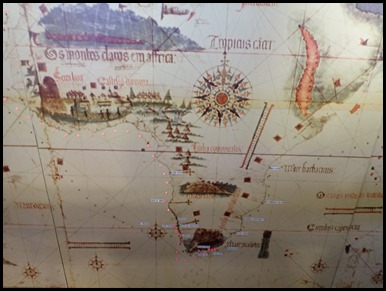 Of course we
rushed up to press the buttons. The first lit the route
taken by Diogo Cao in 1482, he hugged the west coast of Africa as did
Bartolomeu Dias in 1488 (harder to see the little
lights as they are in a pale pink).
 Vasco Da Gama’s route in 1497 (little
yellow lights) that saw him stay well off the coast, the route we will take en
route to St Helena.
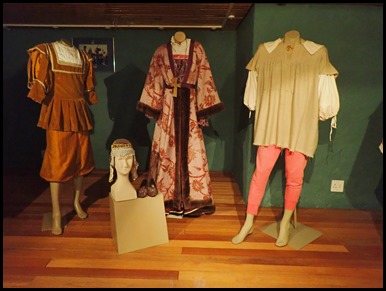  Portuguese fashion of the day.
 Then we entered the main hall and
wow. Historical Background: King Joao (John) II of Portugal, inspired by his
great uncle, Prince Henry the Navigator, was determined to find a sea route to
India via the southern tip of Africa.
In 1482 he sent Diogo Cao with
two ships to survey and chart the west coast of Africa. Cao, on his first and
second voyages paved the way for Bartolomeu Dias, who left Lisbon in August 1487
with two caravels of 100 tons each, and a bigger store-ship.
Dias sailed along the coast of
Africa as far south as a harbour later known as Bala dos Tigress. He passed
Cao’s furthest padrao at Cape Cross. With the northern Cedarberg in sight, Dias
probably grew tired of tacking against a stormy southern wind, and sailed out
into the open sea.
Thus he sailed round the southern
tip of Africa without realising it. It was when he steered eastward and could
not any land that he took a northerly course, thereby seeing land again at the
Gourtis River or Rio dos Vaqueiros.
Here the waves prevented him from
landing, but on the festival day of St Blaise, he managed to do so further on in
a protected cove. It later became known as “Aguada de Sao Bras” (watering place
of Saint Blaise). because of the freshwater spring found there. This was later
renamed Mossel Bay by the Dutch. For several years after this the Portuguese
touched Sao Bras to take on fresh water and meat.
In the mid 17th century the Dutch
East India Company decided to set up a refreshment station at the Cape, and it
was yet another hundred years before any settlement at Mossel Bay itself was
planned.
The Maritime Museum was erected
in 1901 to serve as a grain and saw mill. In 1987 it was adapted to serve as a
unique maritime museum. A life-size replica of Dias’
caravel is on display together with all aspects of maritime history of
the early Portuguese, Dutch and English navigators.
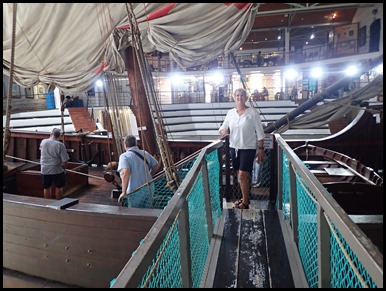  Following Larry, Marlo and Patricia aboard, I turned right and went up the incredibly
steep, narrow steps to the poop deck. Oooo not for
me, the floor slanted downhill from the back and I know I would have felt very
unsteady at sea, especially with such low side rails.
 Looking down on Bear examining what we
all at first thought was one of the life
rafts.
 Looking
forward.
 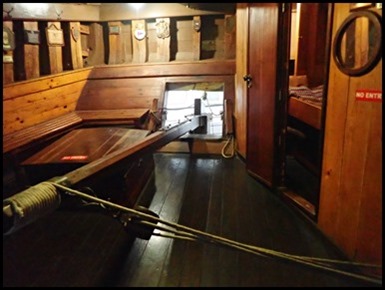 Returning to the main deck, I started
at the back. To my left was the chart table accessed
only if the door was open. The rest of the room – the Round House - (a smallish
area) was the tiller, and to the
right...........
 .......the Captain’s Cabin.
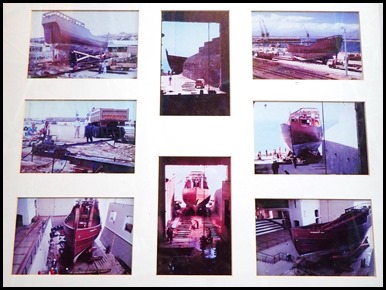 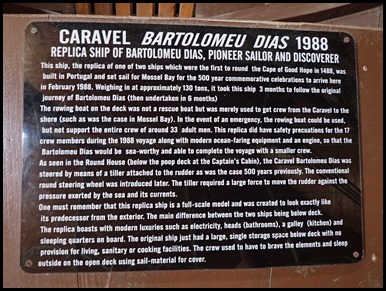 Standing beside the little row boat I
could see what had interested Bear, a picture board showing the caravel’s
journey to the museum. The information boards read: Caravel Bartolomeu Dias
1988. Replica ship of Bartolomeu Dias, Pioneer, Sailor and
Discoverer.
This ship, the replica of one of
the two ships which were the first to round the Cape of Good Hope in 1488, was
built in Portugal and set sail for Mossel Bay for the 500 year commemorative
celebrations to arrive here in February 1988. Weighing in at approximately 130
tons, it took this ship 3 months to follow the original journey of Bartolomeu
Dias (then undertaken in 6 months).
The rowing boat on the deck was
not a rescue boat but was merely used to get the crew from the Caravel to the
shore (such as was the case in Mossel Bay). In the event of an emergency, the
rowing boat could be used, but not support the entire crew of around 33 adult
men. This replica did have safety precautions for the 17 crew members during the
1988 voyage along with modern ocean-faring equipment and an engine, so that the
Bartolomeu Dias would be sea-worthy and able to complete the voyage
with a smaller crew.
As seen in the Round House (below
the poop deck at the Captain's Cabin), the Caravel Bartolomeu Dias was steered
by means of a tiller attached to the rudder as was the case 500 years
previously. The conventional round steering wheel was introduced later. The
tiller required a large force to move the rudder against the pressure exerted by
the sea and its currents.
One must remember that this
replica ship is a full-scale model and was created to look exactly like its
predecessor from the exterior. The main difference between the two ships being
below deck. The replica boasts with modern luxuries such as electricity, heads
(bathrooms), a galley (kitchen) and sleeping quarters on board. The original
ship just had a large, single storage space below deck with no provision for
living, sanitary or cooking facilities. The crew used to have to brave the
elements and sleep outside on the open deck using sail-material for
cover.
  Marlo and I took the steep steps down
to see the ‘luxuries’ for ourselves. The kitchen and
heads did not inspire us to want to spend three
months aboard, that’s for sure......
  The forepeak
storage and galley larder.
 The bunks
did not feel too soft.
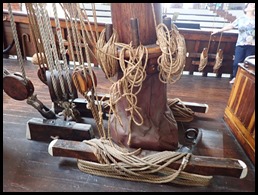  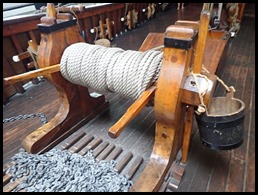 Back on
deck we took in the replica with the modern. Then went to read the whole
transport story.
 A model of the
Dias.
  A model made from
icing sugar. This icing sugar Caravel was made by Mrs. Edith Conway.
It took 140 hours to make and 14kg Huletts Icing Sugar. It is made entirely of
icing sugar, except for the rigging and anchor chain. Mr. Pat Good of Dymond and
Giddy (Pty) Ltd., representatives of S.A. Sugar Association donated it to the
Museum in Mossel Bay.
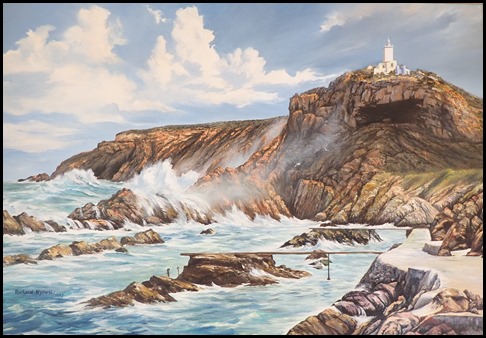 As we left the museum we passed a
painting of the wild sea crashing below the Mossel Bay
Lighthouse. Marlo said we would all head that way and enjoy an ice cream.
Yeah, a bit of wave-watching for me.
 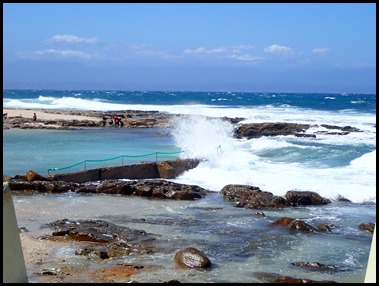 Marlo stopped on the sea front so I
could watch waves hitting and filling the small
lido.
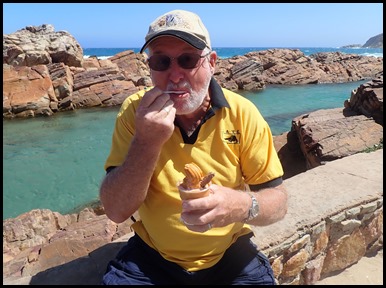  We met the boys car and enjoyed an enormous ice cream each, we did have to sit to leeward
as the stiff breeze wanted to make a spattered mess on our clothes. The sea was incredibly noisy as it crashed through the
rocks.
 I loved the crashing waves......
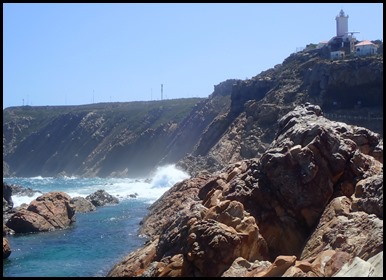 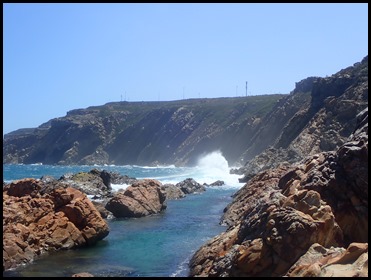 Best as we got looking right toward the lighthouse.
 The boys went off to sort the braai
meat for this evening and Marlo took Patty and me to the top, next to the
lighthouse to indulge me for ten minutes more
wave-watching before we headed to the supermarket. The usual refrain
“shall we get one bottle of Amarula” “No best make it two”. I think best make it
two will go down in history.......
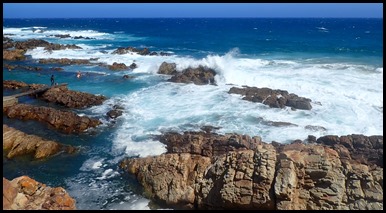  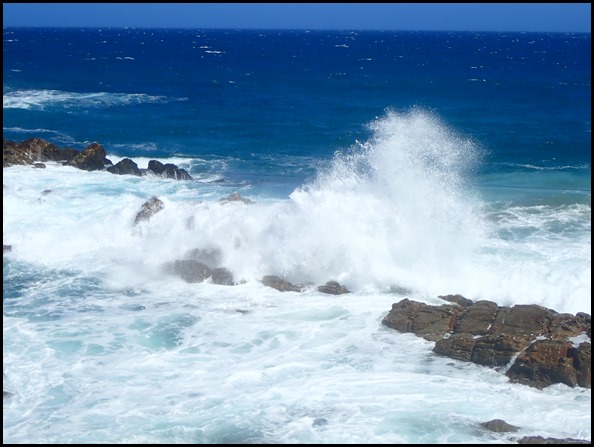 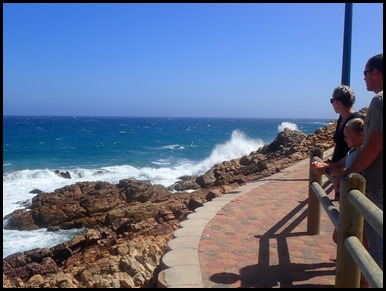 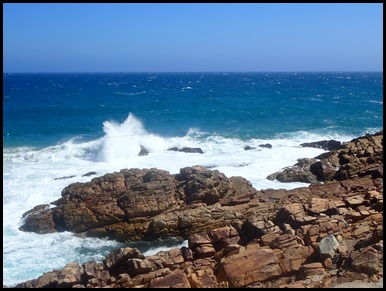 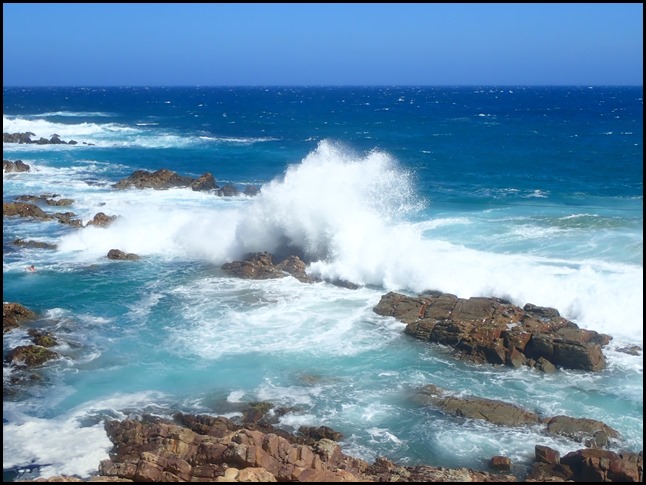 The Wild
Coast is certainly a befitting label......
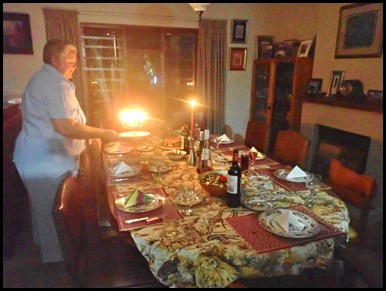 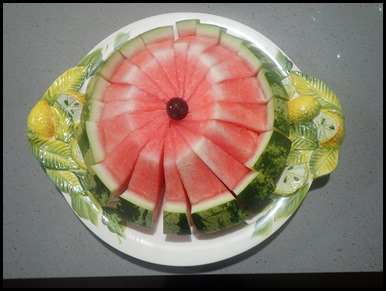 Back home, Marlo
dressed the table and I created the watermelon
with hand holds.
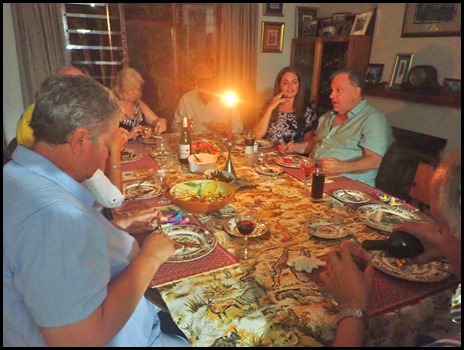 One of Marlo’s brothers (John) and a
family friend with wives joined us for a super
evening, of course the meat was amazing thanks to Larry who is indeed the
braai master.
ALL IN ALL FASCINATING AND
WONDERFUL DAY
A FABULOUS DAY-AND MADE IT
TWO |